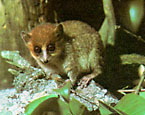The Cheirogaleidae is a small family of small (60 g to around 1 kg), mouse-like strepsirhines, sometimes considered to be a subfamily of the Lemuridae (although affinities with the lorids have also been suggested). Its members (4 genera and 7 species) are found only in Madagascar. They are omnivorous, feeding mostly on insects and fruit. They forage at night and are excellent leapers and climbers. Generally they live solitarily or in pairs.
Cheirogaleidae
dwarf lemurs, mouse lemurs
In addition to being small, cheirogaleids are characterized by a an unusually long tail, ranging from about the length of the body to roughly half again as long; thin and membranous ears; and well developed facial and carpal vibrissae. Their hind foot has an elongated calcaneus and navicular. As with other strepsirhines, they have a distinctive "toilet claw" on the second digit of their hind feet. Their thumb (pollex) is not as conspicuously separated from the other digits as in lemurs; and the third and fourth digits of both feet are similar in length.
Cranially, cheirogaleids are defined by details of their cranial circulation and bullae. The frontal and palatal bones contact the orbit in most cheirogaleids. They have the typical strepsirhine tooth comb made up of lower incisors and canines, and their dental formula is 2/2, 1/1, 3/3, 3/3 = 36. In contrast to lemurs, their upper incisors are elongate. Hypocones are small are absent on the upper molars.
Cheirogaleids have no fossil record.
HOME
Primates
Primate FAQ
Primate Species
Search Primates.com
Dwarf Lemur Pictures
Mouse Lemur Pictures
Primates E-Mail Service
The Smallest Primate in the World
